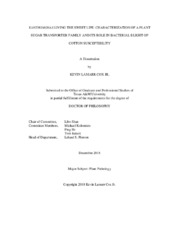| dc.contributor.advisor | Shan, Libo | |
| dc.creator | Cox Jr., Kevin Lamarr | |
| dc.date.accessioned | 2019-01-23T21:13:43Z | |
| dc.date.available | 2020-12-01T07:32:24Z | |
| dc.date.created | 2018-12 | |
| dc.date.issued | 2018-11-26 | |
| dc.date.submitted | December 2018 | |
| dc.identifier.uri | https://hdl.handle.net/1969.1/174560 | |
| dc.description.abstract | Upland cotton (Gossypium hirsutum) is an important cash crop that is constantly pressured by various biotic stresses. Bacterial blight of cotton (BBC) caused by Xanthomonas citri subsp. malvacearum (Xcm) is a destructive disease that limits cotton production worldwide. Xcm causes disease by injecting transcription activator-like (TAL) effectors in plant cell to directly induce the expression of host genes. Despite having at least 10 TAL effectors cloned from Xcm, there have yet to be any susceptibility or resistance proteins identified and characterized. The rapid re-emergence of this disease in the last few years in the US calls for pressing needs to decipher the molecular mechanisms of BBC in order to provide resources to combat this pathogen.
In this dissertation study, I identified a plant sugar transporter (GhSWEET) gene family in cotton that plays an important role in BBC susceptibility. To bypass the traditional map-based cloning to identify susceptibility targets, a combination of genome-wide transcriptome profiling and computational prediction of TAL effector binding sites, coupled with functional characterization of candidate genes was used to identify GhSWEET10 as a key susceptibility target of Avrb6, a major TAL effector in the strain of XcmH1005. This was the first reported susceptibility gene in cotton. Additionally, my data suggest that activating different GhSWEETs by a repertoire of TAL effectors is a common, but important, strategy for Xcm to cause infection, as current Xcm field isolates activated two different GhSWEETs, GhSWEET14a and GhSWEET14b. Further functional analysis on these two SWEETs revealed that activating
expression of GhSWEET14a and GhSWEET14b was correlated with disease susceptibility and genetically required for Xcm to cause infection on cotton. Finally, by using genome editing and artificial microRNAs, I was able to develop strategies that could potentially be used to biologically control of BBC. In conclusion, my dissertation revealed the molecular mechanism of BBC and provided a set of toolkits that could be used in the future to develop BBC-tolerant cotton cultivars. | en |
| dc.format.mimetype | application/pdf | |
| dc.language.iso | en | |
| dc.subject | Cotton | en |
| dc.subject | Xanthomonas | en |
| dc.subject | Transcription Activator-Like effectors | en |
| dc.subject | SWEET | en |
| dc.subject | Bacterial blight of cotton | en |
| dc.title | Xanthomonas Living the SWEET Life: Characterization of a Plant Sugar Transporter Family and its Role in Bacterial Blight of Cotton Susceptibility | en |
| dc.type | Thesis | en |
| thesis.degree.department | Plant Pathology and Microbiology | en |
| thesis.degree.discipline | Plant Pathology | en |
| thesis.degree.grantor | Texas A & M University | en |
| thesis.degree.name | Doctor of Philosophy | en |
| thesis.degree.level | Doctoral | en |
| dc.contributor.committeeMember | Kolomiets, Mike | |
| dc.contributor.committeeMember | He, Ping | |
| dc.contributor.committeeMember | Isakeit, Tom | |
| dc.type.material | text | en |
| dc.date.updated | 2019-01-23T21:13:43Z | |
| local.embargo.terms | 2020-12-01 | |
| local.etdauthor.orcid | 0000-0003-4715-4691 | |


